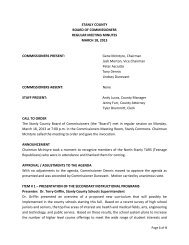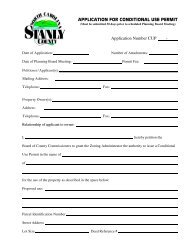Land Use Plan – 2002 - Stanly County, North Carolina
Land Use Plan – 2002 - Stanly County, North Carolina
Land Use Plan – 2002 - Stanly County, North Carolina
You also want an ePaper? Increase the reach of your titles
YUMPU automatically turns print PDFs into web optimized ePapers that Google loves.
STANLY COUNTY<br />
9. Cooperation between the county, communities, and other entities<br />
offers the best solution to future land use planning in <strong>Stanly</strong> <strong>County</strong>.<br />
<strong>Stanly</strong> <strong>County</strong>, as mentioned throughout the <strong>Land</strong> <strong>Use</strong> <strong>Plan</strong> process, is not alone among <strong>North</strong><br />
<strong>Carolina</strong> counties in feeling the pressure of growth and development seemingly beyond their<br />
control. What could make <strong>Stanly</strong> <strong>County</strong> unique is the manner in which future county<br />
development is tied to the needs and desires of its member communities.<br />
Simply stated, the objectives of the <strong>Land</strong> <strong>Use</strong> <strong>Plan</strong> cannot be met without the involvement and<br />
cooperation of all the political jurisdictions represented in the county. For example, preserving<br />
farmland will not be possible without the cooperation of <strong>Stanly</strong> <strong>County</strong>’s cities and towns in<br />
avoiding expansion of utilities and other urban services through the farm country. Conversely, to<br />
achieve the same goal, <strong>Stanly</strong> <strong>County</strong> will need to remain firm on accepting only compatible<br />
development in the farmland preservation area. Other institutions such as those that are<br />
responsible for road and school construction, as well as park and recreation development will<br />
also need to continue to be engaged in the long-range land use planning process.<br />
To a large extend this process of constructive dialog on the future of <strong>Stanly</strong> <strong>County</strong> is already in<br />
place. As part of the process to develop these draft recommendations the cities of <strong>Stanly</strong> <strong>County</strong><br />
were all invited to provide an estimation of where they would see themselves 10 and 20 years<br />
down the road. Representatives from nearly all the city have participated in the public<br />
involvement process through this point in the planning process. These developments are<br />
extremely positive in fostering a long-lasting and constructive relationship for the future of <strong>Stanly</strong><br />
<strong>County</strong>.<br />
<strong>Land</strong> <strong>Use</strong> Categories<br />
The categories used for the <strong>Land</strong> <strong>Use</strong> <strong>Plan</strong> for <strong>Stanly</strong> <strong>County</strong> (see Figure 6-1) are described<br />
below. As indicated in Table 6-2, the land use categories proposed for the <strong>Land</strong> <strong>Use</strong> <strong>Plan</strong><br />
present general land use recommendations for different areas of the study area. Specific land<br />
uses are not indicated for each of these categories (see Table 6-2). The purpose of these<br />
general recommendations is to identify areas of <strong>Stanly</strong> <strong>County</strong> where development is and is not<br />
encouraged over the next 20 years<br />
Primary Growth Areas<br />
The primary growth areas identified on Figure 6-1 represents those areas of <strong>Stanly</strong> <strong>County</strong><br />
where growth and development is encouraged over the next 10 years. Primary growth areas are<br />
identified for each of the eight cities located within <strong>Stanly</strong> <strong>County</strong> and surrounding some<br />
unincorporated towns.<br />
Within the primary growth area, development densities are encouraged from a minimum density<br />
of four dwelling units per acre. For those portions of the primary growth area located nearer the<br />
city center, higher development densities are to be expected and encouraged.<br />
Each primary growth area will include land uses in addition to residential development.<br />
Commercial development is encouraged as is industrial development. New community facilities<br />
such as schools, libraries, and post offices are also encourage as are churches, neighborhood<br />
and community parks, and other activities that support safe and pleasant residential<br />
neighborhoods. Traditional Neighborhood Design (TND) is encouraged as a solution to promote<br />
good community design for developments at the density of four dwelling unit per acre or higher.<br />
Although the principles and philosophy behind TND are discussed later in the report, TND<br />
promotes a mix of land uses that in turn encourages walkability. TND is compatible with the<br />
primary growth area since most existing communities in <strong>Stanly</strong> <strong>County</strong>, most of which were<br />
designed and built prior to World War II, were developed using TND principles as a fundamental<br />
matter of design. To promote use of the TND development model, density bonuses should be<br />
<strong>Land</strong> <strong>Use</strong> <strong>Plan</strong> 6-10 6/02






